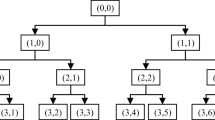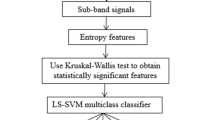Abstract
The gear cracks of gear box are one of most common failure forms affecting gear shaft drive. It has become significant for practice and economy to diagnose the situation of gearbox rapidly and accurately. The extracted signal is filtered first to eliminate noise, which is pretreated for the diagnostic classification based on the particle filter of radial basis function. As traditional error back-propagation of wavelet neural network with falling into local minimum easily, slow convergence speed and other shortcomings, the particle swarm optimization algorithm is proposed in this paper. This particle swarm algorithm that optimizes the weight values of wavelet neural network (scale factor) and threshold value (the translation factor) was developed to reduce the iteration times and improve the convergence precision and rapidity so that the various parameters of wavelet neural network can be chosen adaptively. Experimental results demonstrate that the proposed method can accurately and quickly identify the damage situation of the gear crack, which is more robust than traditional back-propagation algorithm. It provides guidances and references for the maintenance of the gear drive system schemes.












Similar content being viewed by others
References
Chen H, Shang Y, Sun K (2013) Multiple fault condition recognition of gearbox with sequential hypothesis test. Mech Syst Signal Process 40:469–482
Wang D, Sun S, Peter WT (2015) A general sequential Monte Carlo method based optimal wavelet filter: a Bayesian approach for extracting bearing fault features. Mech Syst Signal Process 52:293–308
Kerdphol T, Qudaih Y, Watanabe M, Mitani Y (2016) RBF neural network-based online intelligent management of a battery energy storage system for stand-alone microgrids. Energy, Sustain Soc 6(1):5
Chen H, Lu Y, Tu L (2013) Fault identification of gearbox degradation with optimized wavelet neural network. Shock Vib 20(2):247–262
Fucai L, Guang M, Lin Y, Peng C (2008) Wavelet transform-based higher-order statistics for fault diagnosis in rolling element bearings. J Vib Control 14(11):1691–1709
Zhang G, Jiang XL, Liu ZJ, Chen CC (2014) Pile defect intelligent identification based on wavelet analysis and neural networks. Appl Mech Mater 608
Qian H, Dongxiang J, Liangyou H et al (2008) Application of wavelet neural networks on vibration fault diagnosis for wind turbine gearbox. Adv Neural Netw 5264:313–320
Androvitsaneas VP, Alexandridis AK, Gonos IF, Dounias GD, Stathopulos IA (2016) Wavelet neural network methodology for ground resistance forecasting. Electric Power Syst Res 140:288–295
Sanz J, Perera R, Huerta C (2007) Fault diagnosis of rotating machinery based on auto-associative neural networks and wavelet transforms. J Sound Vib 302(4–5):981–999
Goyal D, Pabla BS, Dhami SS (2017) Condition monitoring parameters for fault diagnosis of fixed axis gearbox: a review. Arch Comput Methods Eng 24(3):543–556
J Kennedy, RC Eberhart (1995) Particle swarm optimization. In: Proceeding of IEEE international conference on neural networks. Perth, Australia, pp. 1942–1948
Garnier S, Gautrais J, Theraulaz G (2007) The biological principles of swarm intelligence. Swarm Intell 1:3–31
Vitorino LN, Ribeiro SF, Bastos-Filho CJ (2015) A mechanism based on artificial bee colony to generate diversity in particle swarm optimization. Neurocomputing 148:39–45
Ardehali MM, Sirizi JM (2013) Particle swarm optimization based fuzzy logic controller for autonomous;green power energy system with hydrogen storage[J]. Energy Convers Manag 65(1):41–49
Aghdam MH, Heidari S (2015) Feature selection using particle swarm optimization in text categorization. J Artif Intell Soft Comput Res 5(4):38–43
Trelea IC (2003) Particle swarm optimization algorithm:convergence analysis and parameter selection[J]. Inf Process Lett 85(6):317–325
Yu D, Yang Y, Cheng J (2007) Application of time-frequency entropy method based on Hilbert-Huang transform to gear fault diagnosis. Meas J Int Meas Confed 40(9–10):823–830
Andrade FA II, Esat MNM Badi (2001) Gear condition monitoring by a new application of the Kolmogorov–Smirnov test. Proc Inst Mech Eng Part C-J Mech Eng Sci 215(6):653–661
Tian X (2004) Dynamic simulation for system response of gearbox including localized gear faults. M.Sc. thesis, University of Alberta
Krambergel J, Sraml M, Glodez S (2004) Computational model for the analysis of bending fatigue in gear-s. Comput Struct 82(23–26):2261–2269
Chen H, Tu L, Sun K, Liu C (2014) An optimized particle filter for signal de-noising processing. Advances in machining and manufacturing technology XII[C]. Key engineering materials vols 589–590, pp 629–633
Chen H, Zuo MJ, Wang X, Hoseini MR (2010) An adaptive Morlet wavelet filter for time-of-flight estimation in ultrasonic damage assessment. Measurement. 43:570–585
Shi Y, Eberhart RC (1998) Parameter selection in particle swarm optimization. In: Proceedings of seventh annual conference on evolutionary programming, pp 591–600
van Ast J, Babuska R, De Schutter B (2008) Particle swarms in optimization and control. In: Proceedings of the 17th World Congress the international federation of automatic control. Seoul, Korea, pp. 5131–5136, 6–11 July, 2008
Acknowledgements
The project is supported by the National Natural Science Foundation of China (Grant no .61273176), Program for New Century Excellent Talents in University of Minister of Education of China (201010621237) and Scientific Research Foundation for the Returned Overseas Chinese Scholars, State Education Ministry(20091001).
Author information
Authors and Affiliations
Corresponding author
Ethics declarations
Conflict of interest
All authors declare that they have no conflict of interest.
Rights and permissions
About this article
Cite this article
Yang, L., Chen, H. Fault diagnosis of gearbox based on RBF-PF and particle swarm optimization wavelet neural network. Neural Comput & Applic 31, 4463–4478 (2019). https://doi.org/10.1007/s00521-018-3525-y
Received:
Accepted:
Published:
Issue Date:
DOI: https://doi.org/10.1007/s00521-018-3525-y




